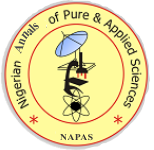Effect of Pre-Treatment Methods on the Quality Attributes of Tomato Powder
Keywords:
Tomato, chemical pretreatment, oven drying, powder, proximate, antioxidants, shelf life.Abstract
Pretreatment of tomatoes into powder reduces spoilage and postharvest loses; however, maintaining the nutritional quality of the powder poses a challenge. Thus, a quantitative approach was employed to measure the effect of some pretreatment methods of making tomato powder, where fresh tomatoes were blanched and exposed to different pre-drying treatments (untreated, treatment with 2% NaCl, 2% CaCl and 0.25% Na2S2O2). These samples were then oven dried at 60oC for 8 h before blending to the various powders. The proximate parameters (ash, fibre, protein, CHO, fats, moisture), physic chemical, antioxidants, colour and microbial parameter of the powder samples were then determined over a duration of 3 months. Results of the study showed that oven drying and chemical pretreatment significantly increased the nutrient component of the tomato powder and decreased cfu/g of bacteria, which could enhance the shelf life of the product. The antioxidants properties such as lycopene, B carotene, Vitamin C, and colour were significantly retained with chemical pretreatment. All pretreated samples retained more nutrients and reduced microbial load of tomato powder. That of Na2S2O5 retained more nutrients while CaCl2 retained more antioxidant properties. The NaCl treated powdered samples retained more ash and total fiber. Similar observations were made for antioxidants properties. L*a*b values of colour were higher at month 0 and lowest at month 3, this implies that at month 3, traces of undesired colour change began and as such, storage beyond this time may be unhealthy. Also, at month 0, Na2S2O5 retained higher values of colour (L*a*b) whereas CaCl2 retained more at month 3. There was a gradual increase in the bacteria and fungi load as the storage period increased. The pre-drying treatments adopted showed potentials to enhance the quality and shelf life of tomato powder although may not be encouraged beyond 3 months of storage.
References
Adebisi, J.A., Oyewo, E. B. and Jibodu, I.S. (2014). Vitamins A, C and Lycopene Contents of Some Varieties of
Tomato and Pepper in the Southwest Region of Nigeria. Advances in Life Science and Technology, 23:63-67.
Adegoke, G.O. (2000).Understanding Food microbiology, Shalon Prints (latex Copco) Ibadan, pp. 53-57
Aderibigbe, O.R., Owolade, O.S., Egbekunle, K.O., Popoola, F.O. andJiboku, O.O. (2018). Quality attributes of
tomato powder as affected by different pre-dryingtreatments. International Food Research Journal 25(3): 1126-
Association of Official Analytical Chemist (AOAC) (1995). Non-enzymatic methods of crude protein contents
determination, official methods of analysis international. 16 th Edition, International, Maryland, USA; 1995.
Atares, L., Chiralt, A., Gonzalez-Martinez, C. (2009). Effect of the Impregnated Solute on Air Drying and
Rehydration of Apple Slices (cv. Granny Smith). 91:305-310.
Baloch, W.A., Khan, S. and Baloch, A.K. 2006. Influence of chemical additives on the stability of dried tomato
powder. International Journal Food Science and Technology, 32(2): 117-120.
Camargo, W.P. and Mazzei, A.R. (1996) Necessidade de reconversao da producao deTomato em Sao Paulo: acoes
na cadeia produtiva. Informacoes Economicas, SP, 26(6):105-116.
Ferreira, M.D., André, T.O.F., Ricardo, F.K., Antonio. C.O., Sylvio, L.H. and Marcelo, T. (2005). Post-harvest
quality of fresh-marketed tomatoes as a function of harvest periods. Scientific Agriculture, (Piracicaba, Braz.)
(5): 446-451
Ferrer O.J., Marshall W.S. and Otwell MR (1989). Effect of Bisulfite on Lobster Shell Phenoloxidase. J.
Food Sci. 54:478-480.
Gaithersburg, M.D., Horwitz, W. and Latimer, G.W. (2005). A.O. Official Methods of Analysis.17th Edition,
Association of Official Analytical Chemists, Washington, D.C.
Gonçalves, E.M., Joaquina, P., Marta, A. and Cristina, L.M.S. (2010) Carrot (Daucus carota L.) peroxidase
inactivation, phenolic content and physical changes kinetics due to blanching. Journal of Food Engineering 97(4):
-581.
Heredia, A., Barrera, C. and Andres, A. (2007). Drying of cherry tomato by a combination of different dehydration
techniques. Comparison of kinetics and other related properties. Journal of Food Engineering 80(1): 111-118.
ICMSF. 1978. Microorganisms in Foods. 1. Their Significance and Methods of Enumeration, 2 nd Ed.
University of Toronto Press, Toronto– 1980. Microbial Ecology of Foods. Vol. 2. Food Commodities.
Academic Press, New York
Jayathunge, K.G., Kapilarathne, R.A., Thilakarathne, B.M., Fernando, M.D., Palipane, K.B. and Prasanna, P.H.
(2012) Development of a methodology for production of dehydrated tomato powder and study the acceptability of
the product. Journal of Agricultural Technology, 8(2): 765-773.
Kolawole O.M., Ayiboye A.E., Aturu E.E. and Anibijuwun I.I. (2011). Effect of solar drying on the
proximate and microbial composition of Abelmoschus esculentus. Journal of Microbial and
Biotechnology Research. 1: 71 – 81.
Krishnaiah D, Devi T, Bono A, Sarbatly R.(2017) Studies on phytochemical constituents of six Malaysian
medicinal plants. J. Med. Plants Res. 2009:3(2):67-72.
Lewicki, P.P., Vu, L., Hoa, and Pmaranska-Lazuka, W. (2002). Effect or pretreatment on convective drying of
tomatoes. Journal of Food Energy. 54: 141-146.
Mozumder, H.M., Rahman, M.A., Kamal, M.S., Mustaf, A.K. and Rahman, M.S. (2012). Pre-drying
Chemical Treatments on Quality of Cabinet Dried Tomato Powder. Environ. Sci. & Natural Resources,
(1): 253-265.
Mwende, R; Owino, W; and Imathiu, S (2018) Effects of pretreatment during drying on the antioxidant properties
and color of selected tomato varieties DOI: 10.1002/fsn3.581
Narsing, RG. Prahbakara,R.P.G., Jyothirmayi, T. and Rao, D.G. (2008). Chemical composition,
standardization and storage studies on raw mango chutney. Journal of Food Science and Technology,
(5):436-438.
Olaniyi I.J, Bulya T. E, Hussein J. B and Ihekwoaba C H (2017) Effect of Drying Methods on the Quality
of Tomato and Pepper Powder. BAOJ Food Sci&Tec 1: 008.
Onwuka G.L. (2005). Food analysis and instrumentation theory and practice. Napthali Prints, Lagos, Nigeria, pp.
-125.
Piaocaro, F., Torreggiani, D. and Gilardi, G. (1993). Inhibition of apple polyphenol oxidase by ascorbic
acid, citric acid and sodium chloride. J. Food Proc. Preserv. 17(2): 1-30.
Reihaneh A. G and Mehdi G D. (2009). Effect of Chemical Pretreatments and Dehydration Methods on
Quality Characteristics of Tomato Powder and Its Storage Stability. International Journal of Biological,
Biomolecular, Agricultural, Food and Biotechnological Engineering Vol: 3, No: 6.
Rodriguez-Amaya, D.B. and Kimura, M. (2004).Harvest plusHandbook for Carotenoid Analysis.pp. 16-
Rossello C, Berna A, and Mulet A (2000). Solar drying of fruits in a Mediterranean climate.
Drying Technol., 8 (2): 305 – 321.
Sadler, G. D. and Murphy, P. A. (2010). pH and titratable Acidity. In Nielson, S. S. (Ed): Food Analysis. P. 219-
New York, USA: Spring.
Sarker, M., Hannan, M.A., Quamruzzaman., Ali, M.A. and Khatun, H. (2014). Storage of tomato powder
in different packaging materials. International Journal of Agricultural Technology. 10(3):595-605.
Sarker, M; Hannan, M. A; Quamruzzaman, M.A; Ali, H; Khatun H. (2014) Storage of tomato powder in
different packaging materials. Journal of Agricultural Technology, 10(3):595-605.
Shi, J.X. (2000). Lycopene in tomatoes: chemical and physical properties affected by food processing. Critical
Reviews in Food Science and Nutrition, 40(1): 1-42.
Tigist, M., Workneh, T. S., and Woldetsadik, K. (2013). Effects of variety on the quality of tomato stored
under ambient conditions. Journal of food science and technology, 50(3), 477–486. Doi: 10.1007/s13197-
-0378-0
Underhill J. E. (1989) pH without pain. The Grapevine: A newsletter for winemakers in British Columbia.
Uwaegbute AC (1989). Vegetables; nutrition and utilization in food crops production, utilization and nutrition. In:
Mbah, BN, Nnanyelugo DO (eds) Dotan Publications Limited, Ibadan.
Woodwall, A., Lee, S.W., Weesie, R. and Jackson M. and Britton G. (1997). Oxidation of carotenoids by
free radicals: relationship between structure and reactivity. Biochimica et Biophysica Acta (BBA) –
General Subjects, 13(36): 33-42.
Zanoni, B., Peri, C., Nani, R. and Lavelli, V. (1999) Oxidative heat damage of tomato halves as affected by drying.
Food Research International, 31(5):395–401.
Downloads
Published
How to Cite
Issue
Section
License
Copyright (c) 2023 Leke L., Bembur K.

This work is licensed under a Creative Commons Attribution-ShareAlike 4.0 International License.



 Contact Us
Contact Us Editorial Team
Editorial Team Join As A Reviewer
Join As A Reviewer  Request For Print Copy
Request For Print Copy


 Cprint Publishers
Cprint Publishers